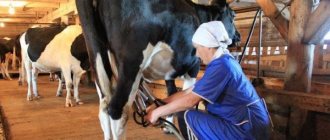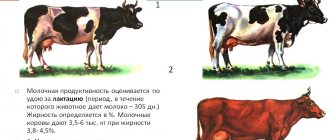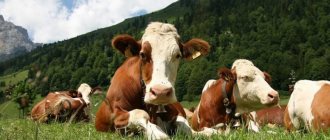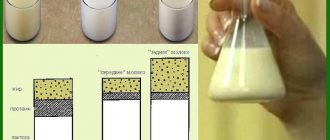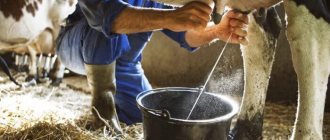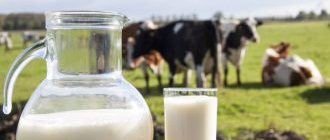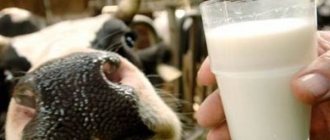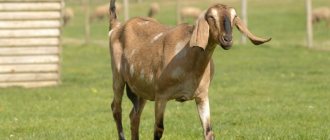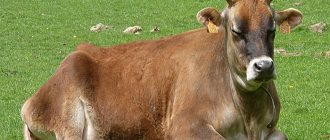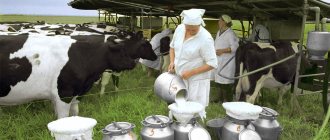Cattle breeds have been selected on our Earth for the last 300 years. The goal of these selections is to create animals that can most efficiently convert feed into valuable cow's milk or high-quality beef.
There are up to 250 breeds of cattle in the world. According to their economically useful qualities, they are divided into dairy, dairy-meat and meat ( Table 1
). Beef cows also produce dairy products, but their quantity is maintained at a level that only ensures feeding of young animals. This is due to the fact that the physiological processes associated with the formation of milk and meat are completely different. Traditionally, the most common and popular beef cattle were British breeds created in the 18th and 19th centuries. It was these animals that became the basis for meat production in America, Australia, some regions of Asia, Eastern and Southern Africa, continental Europe, the territory of the former USSR and Japan.
Cattle milk has been used by humanity for food for more than six thousand years. Today, the share of cow's milk in the total amount of dairy products consumed is 95%.
More than 20 breeds of cattle are bred in our country. Among them, such breeds as the Kazakh White-headed and Black-and-White have acquired the greatest importance. Other breeds of cattle are still bred zonally.
Kazakh white-headed breed
The breed of meat productivity was created on a large territory of the steppe regions of the Kazakh SSR, Orenburg, Volgograd and Saratov regions. In the initial period (1930-1932), the work consisted of the absorption crossing of local Kazakh and Kalmyk
cattle with
Hereford
breeders, subsequently crosses of the first and second generations, corresponding to the desired type, were bred “in themselves”. The new breed sought to combine the high meatiness of Herefords with the positive characteristics of Kazakh and Kalmyk cattle. The Kazakh white-headed breed was approved as an independent breed in 1951. In terms of the number of livestock in our republic, it ranks first.
As selection improved, two types (offspring) of them emerged in the breed. Representatives of the first, main type - meat direction, the second - meat and dairy.
The Kazakh white-headed dog is similar in appearance to Herefords, differing from them in its larger and somewhat rougher head. Cows weigh 500-550 kg, bulls - 850 kg. Calves at weaning from their mothers (8 months old) weigh 240 kg, 18 month old heifers - 320 kg, bull calves - 390 kg. When feeding on steppe pastures, young animals gain weight by an average of 750-850 grams every day. The slaughter yield usually ranges from 53 to 63%. A record slaughter yield - 74.3% - was obtained when slaughtering adult fattened oxen.
The productivity of meat and dairy cows on leading state farms (Karagandinsky, Chalobay) averages 2500 kg of milk with a fat content of 4.0%. The best cows produce from 5000 to 6000 kg of milk per lactation.
The Kazakh white-headed breed is improved both through pure breeding and through introductory crossing of its representatives with Herefords. When selecting and selecting animals, they strive for further consolidation of the breed according to the main economically useful characteristics characteristic of representatives of each breed type. The best breeding Kazakh white-headed cattle are concentrated in the breeding grounds of the Volgograd region.
Advantages of the Kazakh white-headed breed:
– Good acclimatization, endurance;
– Resistance to certain diseases;
– High quality meat;
– Unpretentiousness in feeding.
Auliekol breed
Auliekol cattle breed
meat type. The Auliekol breed was bred in 1992 in the Kostanay region of the Republic of Kazakhstan at the Moskalevsky state processing plant by crossing the local Kazakh white-headed cattle breed with the Aberdeen Angus breed and Charolais. The main distribution zone is the south-eastern part of the Republic of Kazakhstan.
We are accustomed to the fact that meat and fat are located sequentially; The “Auliekol” breed produces so-called marbled meat, where the fat is located between the fibers. This breed is very unpretentious and adapted to our climate, which cannot be said about its ancestors - the French Charolais breed and the English Aberdeen Angus. The Auliekol breed has great potential and is developing successfully and bringing great sustainable profits. Average daily weight gain of a calf: l.5-1.7 kg. Average live weight of one head: 500-600 kilograms. Meat products of this breed are in great steady demand in the Kazakhstan market.
The color is light gray. Most (70%) of the Auliekol breed of livestock are polled. The exterior of animals of this breed is characterized by a strong constitution. In winter, they grow thick hair, which allows them to adapt to harsh climatic conditions.
The live weight of bulls of the Auliekol breed is 950 – 1050 kg, cows – 540 – 560 kg. The average daily gain of bulls is 1095 g. The milk production of adult cows is 228 – 236 kg. Slaughter yield of carcass is 60 – 63%.
Advantages of the Auliekol breed:
· Good adaptation to local conditions
· Unpretentiousness
· High early maturity
· High growth energy
Good yield and excellent meat quality
Holstein breed
The Holstein breed is a breed of cattle for dairy production.
The Holstein breed is the most common breed among dairy cattle on the globe; this breed is also called black and white cattle in the USA and Canada. It originates from the lowland breeds of black-and-white cattle in Western Europe (the Netherlands, Belgium, Luxembourg and partly the northern part of Germany).
Story
Although Holland is considered the birthplace of this breed, it acquired all its wonderful qualities on the American continent. The pioneer of Dutch cattle breeding in America is Winsrop W. Chenery of Belmont, Massachusetts. The history of the breed begins in 1852 when V. Chenery bought a Dutch cow from the captain of a Dutch ship. Due to their high productivity and good adaptive abilities, this cattle has become widespread in North America. In contrast to the direction of breeding work in Holland and other European countries that bred black-and-white cattle, in the USA and Canada it was improved mainly in terms of milk production and live weight, with weak selection for milk fat content. On March 15, 1871, the Society of Breeders for the Breeding of Holstein-Friesian Cattle was organized (president Winsrop Chenery). By 1872, Black and White cattle were already being bred in 12 states, and in the same year the first stud book for the Holstein-Friesian cattle breed was published. Since 1983, in the USA and Canada the breed began to be called Holstein.
Holstein breed
cows have 670-700 kg of live weight, and bulls of this breed have 960-1200 kg. Heifers are born with a live weight of 38-42 kg, and bulls - 44-47 kg. Holstein cows are typically black and white, with black markings of undetermined size.
Cows of this breed, in comparison with black-and-white cows of other breeds, are the most productive, if, of course, they are properly looked after, that is, favorable conditions are created for this. They are used for milk production in a number of countries, including Kazakhstan.
Great importance in breeding the Holstein-Friesian breed is given to identifying record holders for milk yield and the amount of milk fat during lactation and lifetime productivity.
Such outstanding record-breaking cows are known as cow Helen 7336725A, from which 25,047 kg of milk was obtained after the fourth calving, or cow Brie-Zewood Patsy Bert Pontiac 6174402, from which 21,517 kg of milk was obtained during the 9th lactation with a fat content of 4.71 %.
The udder of Holstein-Friesian cows is cup-shaped and capacious. Its index is on average 45-46% (fluctuations from 38.4 to 61.3%). Per day, with double milking, cows produce 60-65 kg or more of milk. The maximum milk flow rate ranges on average from 3.21 to 3.51 kg per minute.
Project characteristics
The business plan of a farm for raising cattle for meat has the goal of creating its own production for raising animals for further sale. The main direction is raising cattle for meat production and its wholesale sale.
In order to implement a ready-made business plan for raising cattle, you will need to have about 1 million 700 thousand rubles on hand. The owner of a future business can invest only part of his personal funds, in the amount of 150 thousand rubles. We plan to formalize the missing part as a subsidy for the development of small businesses.
If we consider this project from an economic point of view, the estimated amount of net annual profit could be 1 million 280 thousand 940 rubles. Full payback of the business will occur no earlier than two years after its opening.
If we consider it as a social indicator, then we will help reduce unemployment by creating additional jobs. In addition, a new business will be registered and funds from taxes will begin to flow into the state budget.
Cattle breeding is a profitable and fast-paying business
In order to start a successful business, you will have to:
- Purchase 60 heads of young cows for the amount of 900 thousand rubles.
- Stock up on animal feed for 600 thousand rubles.
- Carry out construction work to reconstruct the building to keep cows - 150 thousand rubles.
- Thus, at this stage we need to spend 1 million 500 thousand rubles.
- Choosing a taxation system for a business raising cattle
- We will register the future organization as a peasant farm. For the business taxation system, we choose a single agricultural tax. The amount of tax paid is 6% of the organization's profit.
- At the moment, the business plan for raising cattle has begun to be implemented step by step in the following points:
- The process of registering a future business is completely completed.
- Trusted and reliable suppliers of livestock have been found, and the process of preparing documents for signing a purchase agreement has begun.
- The owner of the organization already owns the necessary premises, which includes the presence of 30 heads; a total of 130 heads can be in this room at the same time. The total area is 550 square meters.
Black and white breed
Black and white breed of cows
created by crossing local cattle with black and white Dutch. Depending on the quality of the animals, various groups and types of black-and-white cattle have developed. It ranks second in terms of livestock numbers in Kazakhstan.
In central Russia, it was formed as a result of crossing with an improving breed of Kholmogory, Yaroslavl and other local cattle. Crosses of Swiss and Simmental breeds were partially used.
Thus, large black-and-white cattle with high milk productivity were formed. But in terms of fat content in milk (3.6%), it is inferior to other groups of this breed. Black-and-white cattle of the Urals were bred in the Yekaterinburg region by crossing with improving breeds of Tagil cattle. As a result, large and highly productive animals were created. The black-and-white cattle of Siberia were formed by crossing local Siberian cattle. In recent years, all types of the breed have been actively improved by crossing with Holsteins.
The productive qualities of black-and-white cattle are characterized by the following indicators: live weight of full-aged cows is 550-650 kg, of bulls - 850-960 kg,
Milk yield - 3700-4500 kg for 305 days of lactation (in leading breeding farms - 7000 kg of milk and above). The fat content in milk ranges from 2.5 to 4.8%. Milk contains 3.1-3.4% protein.
In advanced breeding farms, cow productivity is 4.5-6.0 thousand kg of milk per year with a fat content of 3.7-4.26%.
Advantages and disadvantages of business
The business of breeding and selling bull carcasses has advantages.
Beef is in demand due to its taste and healthy composition. In 100 grams: carbohydrates – 0%, proteins – up to 26%, fats – up to 15% and 205 kcal. Bull meat also contains vitamins A, B, D, C, calcium, iron, magnesium.
In addition, the beef market is wide: from cafes and restaurants to factories for the production of semi-finished products.
In addition to bull meat, you can sell manure for up to 200 rubles per bag, and hides for up to 15,000 per piece.
Now about the cons. For a business to be successful, you need to know how to properly care for cattle. Details below in the “Features of care” section.
You will have to spend a lot of time and effort cleaning the barn and caring for the animals.
Another drawback is bull aggression. The problem is solved by amputation of the horns and separate stalls for each animal.
